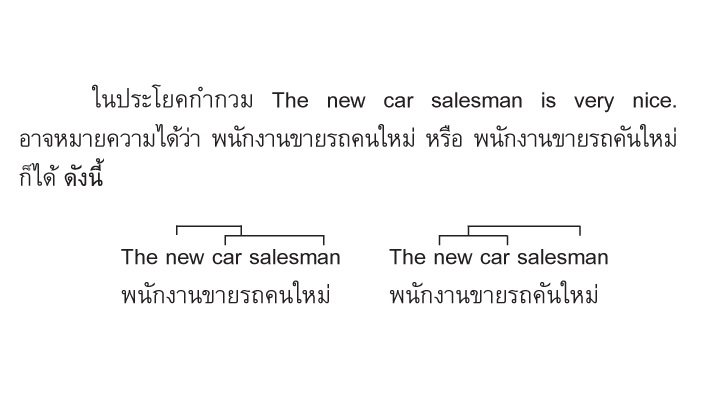
การตีความความกำกวมทางวากยสัมพันธ์ในประโยคภาษาอังกฤษโดยนักเรียนไทย ที่มีประสบการณ์ทางภาษาอังกฤษสูงและต่ำ
INTERPRETATION OF SYNTACTIC AMBIGUITY IN ENGLISH SENTENCES AS DEMONSTRATED BY HIGH AND LOW COMPETENCE THAI LEARNERS
โดย สุวิชา ถาวร / By Suwicha Thaworn
Damrong Journal, Vol 11, No.1, 2012
บทคัดย่อ:
งานวิจัยนี้มีวัตถุประสงค์เพื่อวิเคราะห์และเปรียบเทียบความสามารถในการตีความประโยคภาษาอังกฤษที่มีความกำกวมโดยกลุ่มเจ้าของภาษาและกลุ่มนักเรียนไทยที่มีประสบการณ์ทางภาษาอังกฤษสูงและตำ ข้อมูลที่ใช้ในการวิจัยนี้เป็นข้อมูลที่ได้จากการตีความประโยคกำกวมจำนวน 30 ประโยค คือ ประโยคความเดียว ประโยคความรวม และประโยคความซ้อน โดยใช้กลุ่มตัวอย่าง 3 กลุ่ม คือ กลุ่มเจ้าของภาษา 10 คน กลุ่มนักเรียนไทยที่มีประสบการณ์ทางภาษาอังกฤษสูง 20 คน และนักเรียนไทยที่มีประสบการณ์ทางภาษาอังกฤษตำ 20 คน
ผลปรากฏว่ากลุ่มเจ้าของภาษาสามารถตีความประโยคกำกวมได้ตรงตามเปาหมายร้อยละ 96.8 กลุ่มที่มีประสบการณ์ทางภาษาสูงตีความตรงตามเป้าหมายร้อยละ 93 และกลุ่มที่มีประการณ์ทางภาษาตำตีความตรงตามเปาหมายร้อยละ 69.25 กลุ่มที่มีประสบการณ์ทางภาษาสูงจะตีความประโยคกำกวมได้ใกล้เคียงเจ้าของภาษามากกว่ากลุ่มที่มีประสบการณ์ทางภาษาตำความแตกต่างระหว่างกลุ่มเจ้าของภาษาและกลุ่มที่มีประสบการณ์สูงไม่มีนัยสำคัญทางสถิติ (P = 0.152) แต่ความแตกต่างระหว่างกลุ่มเจ้าของภาษาและกลุ่มที่มีประสบการณ์ตำมีนัยสำคัญทางสถิติ (P = 0.00) การตีความความกำกวมของกลุ่มสูงและกลุ่มตำแตกต่างกันอย่างมีนัยสำคัญทางสถิติ (P = 0.00) การตีความความกำกวมของกลุ่มตำเทียบกับเจ้าของภาษาและเทียบกับกลุ่มสูงแตกต่างกันอย่างมีนัยสำคัญทางสถิติ (F = 82.479, P = 0.00)การศึกษานี้แสดงให้เห็นว่าระดับของประสบการณ์ทางภาษามีผลต่อการตีความสำหรับนักเรียนไทยที่เรียนภาษาอังกฤษเป็นภาษาที่สอง การศึกษาการตีความประโยคกำกวมนี้ชี้ให้เห็นปัญหาในการตีความของนักเรียนไทยซึ่งจะเป็นประโยชน์ในการนำมาประยุกต์ใช้ในการเรียนการสอนภาษาอังกฤษต่อไปได้
ABSTRACT:
The objective of this research is to analyze and compare Englishsentence syntactic ambiguities with their interpretations by native speakers and English language learners. Thirty ambiguous English sentences were used as the foundation for the study; divided into three types: simple sentences, compound sentences and complex sentences. Three sample groups were set up: 1) 10 native speakers; 2) 20 non-native students with high English language competence; 3) 20 non-native students with low English language competence. The results showed that the native speakers correctly interpreted 96.8% of the ambiguous English sentences. The high competence languagelearners correctly interpreted 93% of the ambiguous English sentences,and the low competence English language learners correctly interpreted 69.25% of the ambiguous English sentences. The high competence English language group was able to interpret the ambiguous English sentences to a similar success rate as the native speaker group, and far more successfully than the low competence English language learner group. The difference between the native speaker group and the high competence group was not statisticallysignificant (P= 0.152) whereas the difference between the native speaker group and the low competence group was statistically significant (P= 0.00). The difference between the high competence group and the low competence group was also highly significant (P= 0.00).The differences between the low competence/high competence groups and the high competence/native speaker groups was also shown to be statistically significant (F = 82.479, P = 0.00). The study demonstrates that second language learner levels of competence affects the ability to interpret ambiguous English sentences. This study highlights the problem ‘interpretation of ambiguity’ and offers some suggestions for English language instruction.











